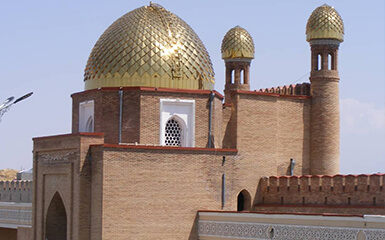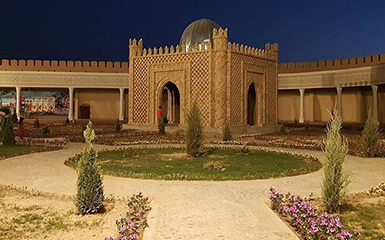Kok Gumbaz
Ajina Teppa
Ancient Panjakent
Anzob Tunnel
Beshkent Qala
Childukhtaron
Khazrati Shokh
Mug Teppa
Gharm Chashma
Hisor Historical
Haji Yaqub mosque
Hazrati-Bobo complex
Lake Iskanderkul
Kalai-Khumb
Karatag
Karon
Khishtin caravanserai
Khorog
Khulbuk
Lake Karakul
Abdullatif Sultan
Madrasai Kuhna
Abu Abdullah Rudaki
Khoja Mashhad
Khudoyor Valami
Makhmudi Azam
Mir Sayyid Ali Hamadani
Muhammed Bashoro
Sheikh Muslihiddin
Nurek Mountain Lake
Pamir
Sarazm
Sari-Khosor
Seven Lakes
Shirkent
Chiluchorchashma
Takht-i Sangin
Fortress Mug Teppa

A unique monument of the Achaemenid period with a peculiar architectural and material culture. It is an archaeological site of the 12th - 4th centuries BC. Its area is 18 hectares, located on the banks of the Nijon River. A defensive wall with a horseshoe-shaped citadel fortifies the object. The earliest layers of the settlement date back to the 7th-4th centuries BC with dwellings of the semi-dugout type. The walls are reinforced with rectangular bricks.
There is a statue of a man leading the camels on the Silk Road to the right of the entrance door. On the wall to the left of this door are reliefs of the war between the Achaemenid and Macedonian armies in 329 BC. There are more interesting reliefs from the Persian period on the walls near the main gate. These include the winged sphinx, an important symbol of the Achaemenid Empire, and the image of Cyrus the Great and the she-wolf feeding Romulus and Remus. A mural of Romulus and Remus was discovered in the Sogdian city of Bunjikath, near Shahristan, and this is regularly seen in Tajikistan.
The landmark, visible from afar, is the citadel hill Mug Teppa (Hill of Fire Worshipers), which rises 1.5 kilometres north of the market. From there, the New Town from Soviet times can be seen to the east and the extensive old town (Shahr-i Kuhna) to the west of the river.
The medieval citadel has disappeared. A city gate with a piece of defensive wall was rebuilt on the south side of the hill, the appearance of which does not necessarily have to match the original from the 16th century. The Sogdian fortress remains from the 3rd century BC. A small remnant of the defensive wall and residential buildings made of adobe bricks have been preserved on the edge of the hill until the 3rd century AD. From the 5th to 8th centuries a two-story tower was uncovered, which is interpreted as a fortress or as a religious building. One of the oldest finds on Mug Teppa is a bronze seal from the 4th to 2nd centuries BC. BC, on which a winged griffin is depicted, and a number of Roman denarii, which document a long-distance trade in the 1st century AD. There are also male figurines made of terracotta from the first centuries BC. BC, religious figures and objects from the 5th to 8th centuries and glazed ceramics painted red or green-brown from the 10th to 12th centuries. Mug Teppa was excavated from the 1920s to the 1950s.

